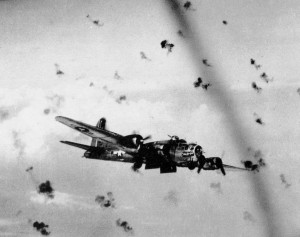06 Mar Flak
According to Miriam-Webster’s on-line dictionary, the word “flak” is from “Fliegerabwehrkanonen” … from Flieger flyer + Abwehr defense + Kanonen cannons.
The Germans had a very effective anti-aircraft weapon which shot missiles toward the Allied aircraft. The “flak” would explode creating a black smoke cloud and sending sharp pieces of metal that would float in the air. If the explosion occurred just under or over the plane, the metal could tear it apart or at minimum cause great damage to plane and crew. Particularly toward the end of the war, more of our aircrews and planes were downed by flak than by enemy aircraft.
The Germans would shoot toward their targets, often from a Flak Tower, and would either aim directly at a plane or send a battery of explosions up to the area where the B-17 formations were headed.
The crew had flak helmets and flak vests to help protect them from injury. On Herman’s 3rd mission, he wrote in his diary that he made sure everyone was wearing their flak suits.
Here is how bombardier Herman F. Allen described his first sighting of flak, as seen from his “bird’s eye” view in the nose:
Up until now I had read about flak, heard about it in the lecture room, seen it on the screen, but a few minutes from the Channel I saw it, visibly with the naked eye, for the first time. It looked harmless enough coming up through the clouds at 11 o’clock. Black puffs, the smoke cleared away, and once again nothing but vapor trails and a slight haze. Hell, I thought, if that’s flak there should be little to worry about. Soon, too damn soon, I was to see how badly I erred.



Tom Sanor
Posted at 14:54h, 18 MarchIn the second paragraph you say, “anti-aircraft weapon that shot missiles toward the Allied aircraft. The “flak” would explode creating a black smoke cloud and sending sharp pieces of metal that would float in the air. If the plane hits the flak…” The anti-aircraft weapons shot a metal shell (bullet)into the air that would explode at a preset altitude (or upon actual contact). When the explosion occured the metal fragments would fly with considerable force in every direction with the hope and expectation that some would hit the Allied aircraft and cause mortal damage. If the explosion was not close enough the plane crew might well hear the impacts which could be described as like pebbles being thrown against the plane. If close, of course, actual damage to the plane could occur. A direct hit meant the plane was finished. I have never heard flak shells described as “missiles”, but those being shot at saw nothing until the explosion, then all they saw was a smoke cloud, “PUFF” of smoke. They never saw the shell, or the resulting metal fragments flying through the air. The metal fragments did not “float” in the air, but the smoke clouds from the explosion did. It is more likely that the description would be “the flak hits the plane” rather than “the plane hits the flak” (like saying “the duck hit my shotgun pellets”) but in actuality it’s a moot point.
Pat
Posted at 07:51h, 19 MarchThank you thank you for the excellent clarification …